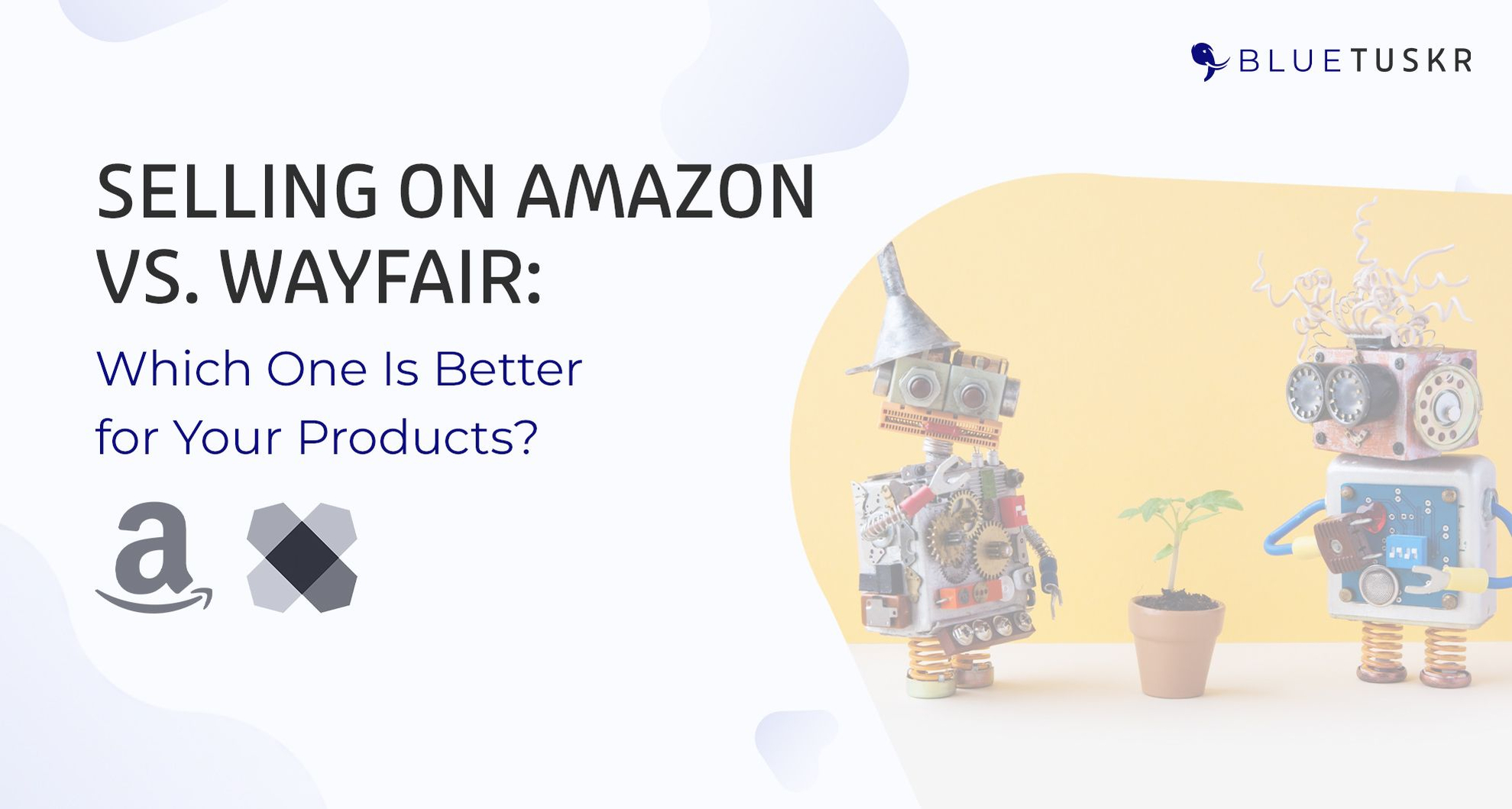
Amazon vs. Wayfair: Which One Is Better for Selling Your Products?
Without a doubt, e-commerce has taken the world by storm. Suddenly, everyone prefers shopping online rather than going to physical stores. This is because online shopping is convenient, and you can find almost anything you need with just a few clicks. According to Statista, e-commerce worldwide has already reached an astounding 4.9 trillion US dollars. The global e-commerce market is expected to reach 7.4 trillion dollars by 2025, with a whopping 50% increase in four years. If you're not selling online, you're missing out on a lot of potential revenue.
Furniture from Across the Globe, Now at Your Fingertips
Back then, buying furniture from other countries was impossible, mainly if you lived on the other side of the world. But, with online shopping, you can now buy that gorgeous marble dining set from Carrara, Italy, with a few clicks of a button.
The furniture industry has greatly benefited from e-commerce in general. Eight out of ten furniture shoppers bought furniture online in 2020, which is projected to rise as the years go by. In 2021, the overall revenue of the furniture companies from e-commerce ballooned to 132.7 million US dollars.
Thanks to e-commerce, the furniture industry is thriving with a growing pool of shoppers browsing their websites and making purchases. Currently, Amazon and Wayfair are two of the most famous names in the online furniture selling industry. Amazon, the online retail platform behemoth that it is, is considered the largest and most popular retail website worldwide traffic.
On the other hand, Wayfair is the largest online-only home furnishings retailer in the United States, earning $13.7 billion in net revenue in 2021. Moreover, Wayfair shoppers are some of the most loyal shoppers in the retail industry, raking in hundreds of millions of dollars in revenue per year. Market research and a great online strategy have also boosted the company's sales, especially during the global pandemic, when everyone wants to buy furniture for their home office.
Now that we have established that these two are considered greats in selling furniture online, one question is floating on top: which one is a better platform for your products? Amazon vs. Wayfair: what's the real deal?
Online Shopping and the Furniture Industry
The furniture industry has been slow to adopt e-commerce, but it's finally starting to catch on, accounting for 17.28% of total e-commerce sales in the US.
Consumers are increasingly looking for convenience and value over brand loyalty and price. They want the ability to shop from their home anytime or night and then have their order delivered right to their doorstep — just like Amazon Prime. This convenience means that more people are willing to spend more money online than they would otherwise spend in a physical store, especially when it comes to big-ticket items like furniture. But there's another reason so many people buy furniture online: they can't find what they want locally.
While other retailers died a slow and painful death with the advent of the Internet and online shopping, the furniture industry has thrived and benefitted from the convenience it offers sellers and buyers.
One of the reasons why furniture sellers survived and even benefitted from the Internet is because of the low overhead costs associated with selling online. For example, a physical store has to pay for rent, utilities, employees, and other expenses that eat into their profits.
An online store doesn't have those same expenses, so they can sell their products for less and still make a profit. This is why you'll often see the furniture for sale online at a fraction of the cost of what you would pay in a physical store.
Lifestyle product photography is essential for selling products on platforms like Wayfair and Amazon because it allows potential customers to envision the products in real-life settings, enhancing their understanding of the item's features and suitability for their own lifestyle or home decor.
Selling on Amazon vs. Wayfair
Now that we have established that Amazon and Wayfair are two of the leading online furniture retailers, it's time to compare and contrast the two platforms.
The Pros and Cons of Selling on Amazon
First, let's take a look at what Amazon has to offer sellers.
Pros of Selling on Amazon
1. Massive Marketplace
As the world's largest online retailer, Amazon has a huge customer base that is always looking for new products. Obviously, Amazon is a massive marketplace with millions of customers ready and willing to buy your products. This gives you a big advantage over other online retailers that don't have nearly as many potential customers. In addition, Amazon is a good starting place for new brands who are still trying to establish themselves in the market or do not have their official website yet.
2. Easy to Use
Another big advantage of Amazon is that it is very easy to use for sellers and buyers. The process of setting up an account and listing products is simple and straightforward. And since Amazon is such a popular platform, plenty of resources are available to help you if you run into any problems. In addition, buyers are already familiar with Amazon, so they know how to use the site and can easily find what they're looking for.
3. Fulfillment by Amazon
Fulfillment by Amazon (FBA) is a program that allows you to store your products in Amazon's warehouses and have them ship the products directly to your customers. This is a great option if you don't have your own warehouse or if you want to free up some space in your home or office. Plus, it can save you a lot of time and money because Amazon will take care of all the packaging and shipping for you. You have to send them your products, and they'll take care of the rest.
4. Prime Shipping
Since Amazon has such a large customer base, they're able to offer Prime shipping, which is free two-day shipping for Prime members. This is a great perk for customers and helps to increase sales for sellers. Plus, Amazon is constantly expanding their Prime shipping program and offering new benefits like same-day and one-day shipping.
5. Amazon Advertising
Amazon advertising is a great way to get your products in front of potential customers who are searching for items like yours. With Amazon advertising, you can create ad campaigns specifically targeted to Amazon users. Plus, you only have to pay when someone actually clicks on your ad, so it's a very cost-effective way to market your products. Furthermore, Amazon also offers analytic tools to help you track your ad campaigns and see what's working and what isn't.
6. Customer Reviews
Customer reviews are extremely important on Amazon, and they can make or break a sale. Potential buyers will often read reviews before making a purchase, so it's important to make sure that your products have good reviews. In addition, you can also use customer reviews as a way to improve your product listings.
7. Customer Experience
Amazon’s popularity is due to its stellar shopping experience. They offer fast shipping that most other eCommerce platforms can’t beat. Most people experiencing same-day shipping can get frustrated with longer shipping times.
Aside from fast shipping, Amazon allows easy refunds and returns. Customers need not wait for weeks or go through hell to get refunds. With these conveniences, Amazon customers are mostly happy.
As a third-party seller, you’ll give the platform your products. Amazon handles the rest of the process. They will even deal with various customer inquiries, meaning complaints and questions go to Amazon instead of your email.
If your products are sourced from overseas, then you need to ensure that the supplier packs and ships the products to Amazon warehouses according to Amazon's requirements. If the factory is not aware of these rules, you need to consider Amazon FBA Prep Services. You can seek out a professional warehousing company, or consider a sourcing agent like SourcingNova.
They will handle their FBA sellers’ returns and refunds. If customers intend to return items, they won’t deliver them to your house. Instead, the items will be safe in the nearest Amazon warehouse
Cons of Selling on Amazon
1. Competition
Since Amazon is such a popular platform, there is a lot of competition. This can make it difficult to stand out from the crowd and get your products noticed. In addition, many big brands are also selling on Amazon, which can make it hard for small businesses to compete. Nonetheless, if you have a unique product or are selling in a niche market, you can still be successful on Amazon.
2. Fees
Amazon also charges fees for listing and selling products on their site. These fees can add up, especially if you're selling multiple products. Most sellers pay between 6% and 45% of each product's selling price in sale-related costs, with the typical seller paying around 15%. Account fees range from $0 to $39.99 per month. You'll also have to fulfill and send your orders, which can vary considerably in price depending on your products and fulfillment setup. If you want your products to be available to Amazon Prime members, you might have to pay even more in fees in exchange for your exposure to Prime members.
3. Lack of Control over Marketing and Branding
When you sell on Amazon, you're essentially renting space from them. This means that you don't have a lot of control over your product listings or your brand as a whole. Amazon also has the right to use your products in their marketing and promotional materials. While this can be beneficial in some cases, it can also be a downside if you're trying to build a specific brand image.
4. Returns
Since customers can't physically inspect your products before they purchase them, there's always the potential for returns. And since Amazon handles all seller returns, this can be time-consuming and frustrating. In addition, if you have too many returns, then Amazon can suspend or even close your account.
5. Amazon's Policies
Since Amazon is the one in control, they can change their policies at any time. And these changes can have a big impact on your business. For example, Amazon recently changed their search algorithm, which significantly affected many sellers' businesses. So it's important to be aware of Amazon's policies and stay up to date on any changes.
Overall, Amazon offers some great benefits like a large customer base, fast shipping, and powerful marketing tools. It can be a great way to reach a larger audience and boost your sales, especially if you are a new business. However, like any other platform, it also has some disadvantages. If you are considering selling on Amazon or are already selling on the platform, then it's important to weigh the pros and cons to decide if it's the right fit for your business.
The Pros and Cons of Selling on Wayfair
Wayfair offers a different selling experience than Amazon. They are an online retailer that specializes in home goods and furniture. They offer a wide range of products, from rugs and curtains to dishware and furniture. And unlike Amazon, Wayfair also offers a platform for businesses to sell their products.
Pros of Selling on Wayfair
1. Lower Fees
Another great thing is that Wayfair does not take cuts from their sellers, unlike Amazon. Instead, they only charge a small commission on each sale, which is typically between 2.5% and 3.5%. This is much lower than the fees charged by Amazon. In addition, there are no monthly account fees. So if you're selling expensive products or items with a high price tag, Wayfair can be a more cost-effective option. They also operate on a wholesale cost model, which means they pay their suppliers the wholesale price of their products before setting the retail price.
In addition, sellers are not responsible for any shipping costs since Mayfair operates on a drop-ship model, so they send the client order to your warehouse before you pick, pack, and ship the goods straight to the customer. Wayfair takes care of all transportation arrangements and expenses.
2. More Control Over Your Pricing and Product Listings
New sellers would love this. If you want to earn more money from selling furniture products on Wayfair, consider setting up an auction instead of a fixed-price sale. Auctioning gives buyers more incentive to bid higher since they know the competition for the item they're interested in buying.
This can help boost your profits when it comes time to sell an item that doesn't have many bids at all — such as a rare piece of artwork or antique item that isn't being purchased often by shoppers looking for similar items through Wayfair's website. This feature is uniquely Wayfair, as Amazon and other platforms do not have this on its website.
Therefore, the sense of exclusivity is yet another perk for your customers since they would feel more inclined to purchase an item from you if they know that not just anyone can put it up for sale.
3. Intuitive Seller Panel
The seller panel is the area where you manage your inventory, orders, and product listings. It's also where you view your sales reports and configure your account settings. Wayfair has an intuitive seller panel that is easy to use and navigate. This makes it simple to keep track of your business and helps you avoid making mistakes that could cost you money. It's a handy feature if you're selling various products on Wayfair. It serves as an online business assistant.
4. Popularity over Home Goods and Furnishings
Wayfair is a popular website for people looking to buy home goods and furnishings. Many furniture sellers prefer selling on Wayfair because it's better for their niche. For example, if you sell vintage furniture, finding a place to sell your items where they won't get lost in the shuffle can be difficult.
Additionally, along with the different categories of items sold on Wayfair, the website also has an entire section of its website devoted to vintage and antique furniture, making it easier for buyers specifically interested in these types of items to find what they're looking for. Wayfair specializes in niche selling, which can be an advantage for you if your products fall into a specific category.
5. Less Competition
The fact that Wayfair is a less popular platform gives you an advantage over other sellers. This is because there are fewer people selling on Wayfair, which means less competition for you. With less competition, it'll be easier for your products to be seen by potential buyers and generate sales.
Cons of Selling on Wayfair
1. Not as Much Traffic
Although Wayfair is a popular website, it doesn't have as much traffic as Amazon. This means that there's less of a chance that potential buyers will see your product. If you want to sell on Wayfair, you'll need to work hard to market your products and make sure they're visible to shoppers browsing the website.
2. Requires More Work
Since Wayfair is not as popular as Amazon, you'll need to do more work to generate sales. This includes marketing your products, optimizing your listings, and providing excellent customer service. If you're not willing to put in the extra effort, selling on Wayfair may not be worth it for you.
3. Not Suitable for All Products
Wayfair is not suitable for all products. For example, if you sell electronics, you're better off selling on Amazon since that's where most people go to buy these types of items. Wayfair is mainly focused on home goods and furnishings, so it's not the best platform for selling other types of products.
4. No Buy Box
The lack of a buy box is a major downside of selling on Wayfair. The buy box is a feature on Amazon that allows shoppers to add items to their cart without having to go to the product listing page. This makes it more likely for shoppers to purchase an item since they can add it to their cart with just a few clicks. Since the company, Wayfair, doesn't have a buy box, you'll miss out on potential sales from shoppers who are too lazy to go to your product listing page.
The Final Verdict: Wayfair or Amazon?
So, which one is better for your products? It really depends on what you're selling and how much work you're willing to put in. Both companies have pros and cons, so it's important to weigh your options before deciding which one is right for you. For example, if you're selling home goods and furnishings, Wayfair is a great option since it's less competitive and specializes in these types of products.
However, if you're selling other types of products, such as electronics, Amazon is a better choice since it's more popular and has a wider selection of products. Ultimately, it's up to you to decide which company is best for your business. As always, do your research first and decide which site is best for your products before listing them for sale.
Interested in Amazon listing optimization services? Contact our team at Bluetuskr, an e-commerce marketing agency.
Connect With Us
Recent Post

.png)







Tell us what you think!